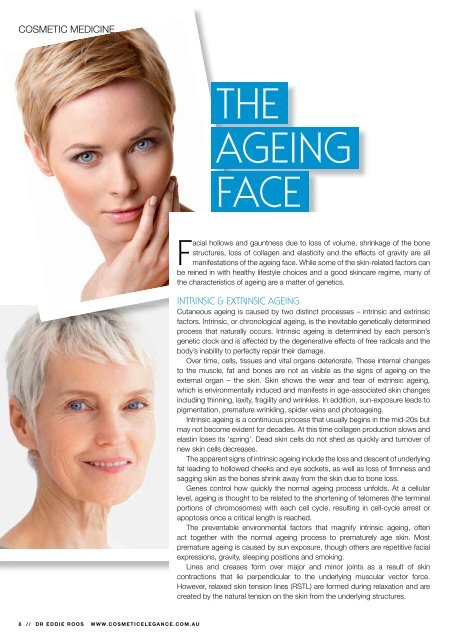You also want an ePaper? Increase the reach of your titles
YUMPU automatically turns print PDFs into web optimized ePapers that Google loves.
COSMETIC MEDICINE<br />
THE<br />
AGEING<br />
FACE<br />
Facial hollows and gauntness due to loss of volume, shrinkage of the bone<br />
structures, loss of collagen and elasticity and the effects of gravity are all<br />
manifestations of the ageing face. While some of the skin-related factors can<br />
be reined in with healthy lifestyle choices and a good skincare regime, many of<br />
the characteristics of ageing are a matter of genetics.<br />
INTRINSIC & EXTRINSIC AGEING<br />
Cutaneous ageing is caused <strong>by</strong> two distinct processes – intrinsic and extrinsic<br />
factors. Intrinsic, or chronological ageing, is the inevitable genetically determined<br />
process that naturally occurs. Intrinsic ageing is determined <strong>by</strong> each person’s<br />
genetic clock and is affected <strong>by</strong> the degenerative effects of free radicals and the<br />
body’s inability to perfectly repair their damage.<br />
Over time, cells, tissues and vital organs deteriorate. These internal changes<br />
to the muscle, fat and bones are not as visible as the signs of ageing on the<br />
external organ – the skin. Skin shows the wear and tear of extrinsic ageing,<br />
which is environmentally induced and manifests in age-associated skin changes<br />
including thinning, laxity, fragility and wrinkles. In addition, sun-exposure leads to<br />
pigmentation, premature wrinkling, spider veins and photoageing.<br />
Intrinsic ageing is a continuous process that usually begins in the mid-20s but<br />
may not become evident for decades. At this time collagen production slows and<br />
elastin loses its ‘spring’. Dead skin cells do not shed as quickly and turnover of<br />
new skin cells decreases.<br />
The apparent signs of intrinsic ageing include the loss and descent of underlying<br />
fat leading to hollowed cheeks and eye sockets, as well as loss of fi rmness and<br />
sagging skin as the bones shrink away from the skin due to bone loss.<br />
Genes control how quickly the normal ageing process unfolds. At a cellular<br />
level, ageing is thought to be related to the shortening of telomeres (the terminal<br />
portions of chromosomes) with each cell cycle, resulting in cell-cycle arrest or<br />
apoptosis once a critical length is reached.<br />
The preventable environmental factors that magnify intrinsic ageing, often<br />
act together with the normal ageing process to prematurely age skin. Most<br />
premature ageing is caused <strong>by</strong> sun exposure, though others are repetitive facial<br />
expressions, gravity, sleeping positions and smoking.<br />
Lines and creases form over major and minor joints as a result of skin<br />
contractions that lie perpendicular to the underlying muscular vector force.<br />
However, relaxed skin tension lines (RSTL) are formed during relaxation and are<br />
created <strong>by</strong> the natural tension on the skin from the underlying structures.<br />
8 // DR EDDIE ROOS WWW.COSMETICELEGANCE.COM.AU


















